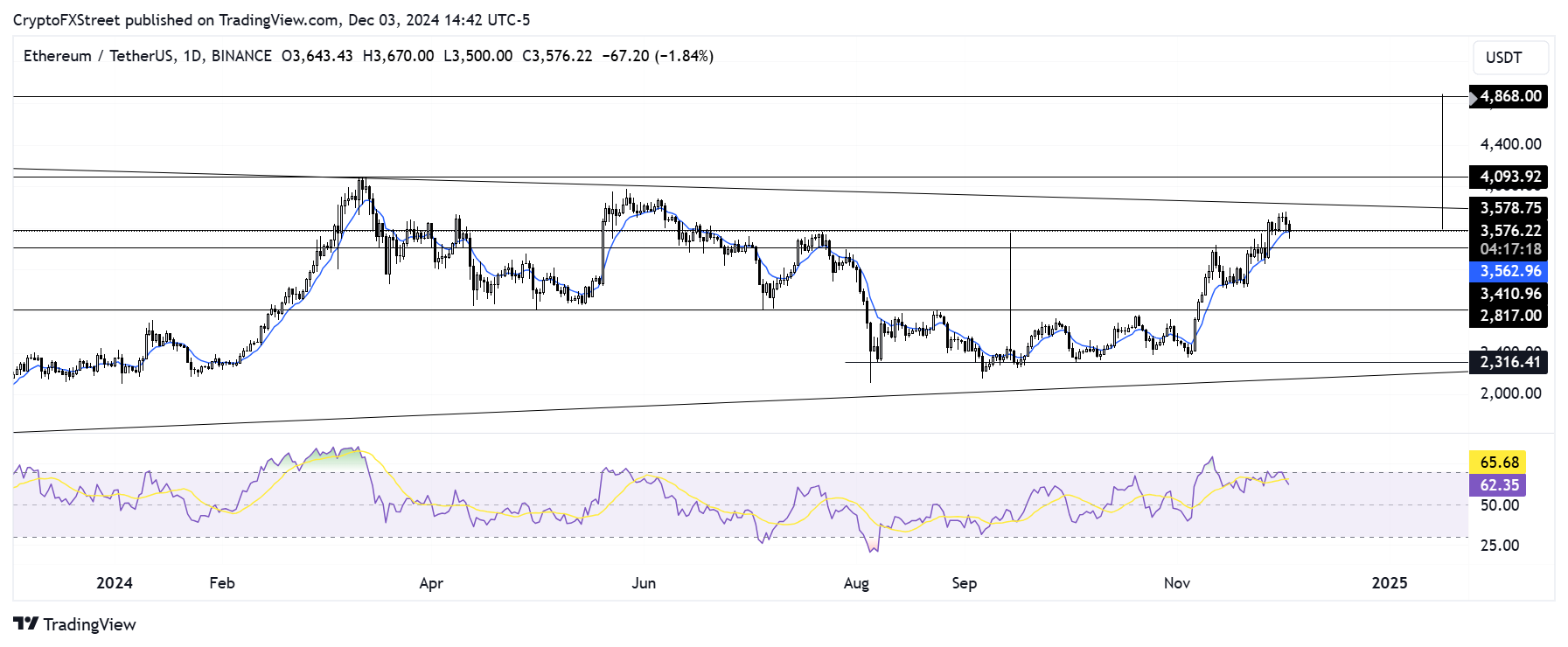Ethereum Price Forecast: Investors purchased $1.2 billion of ETH as key pattern suggest rally toward $4,868
Ethereum price today: $3,570
- Ethereum investors have purchased over $1.2 billion worth of ETH from exchanges in the past five days.
- Ethereum investment products reached a record $2.2 billion in net inflows in 2024.
- Ethereum could tackle its all-time high resistance of $4,868 if it maintains a rounded bottom pattern.
Ethereum (ETH) is down 1% on Tuesday despite heavy accumulation across spot exchanges and investment products. The number one altcoin could rally to tackle its all-time high resistance of $4,868 if it maintains a rounded bottom patern and overcomes a key trendline resistance.
Ethereum investors withdraw $1.2 billion of ETH from exchanges as investment products set new record
Ethereum investors have accumulated over 330K ETH worth nearly $1.2 billion from exchanges in the past five days, according to CryptoQuant's data.
The ETH Exchange Reserve, which measures the total amount of coins held in exchanges, has been on a downtrend since November 28. As the value of coins in exchange reserves declines, it indicates higher buying activity among investors.
-638688516538112023.png)
ETH Exchange Reserve | CryptoQuant
US spot Ethereum ETFs recorded inflows of $24.2 million on December 2, marking the sixth consecutive day of positive flows for the products, per Coinglass data.
Globally, Ethereum investment products have also been witnessing heightened activity, noting inflows of $634 million last week, according to CoinShares digital assets weekly report.
The high inflows have sent their total yearly net flows to $2.2 billion inflows, smashing their 2021 record of ~$2 billion, CoinShares analysts added.
Meanwhile, Ethereum co-founder Vitalik Buterin outlined suggestions that wallet developers could implement to improve the user experience of cross-L2 transactions, wallet security and privacy. He also highlighted how artificial intelligence (AI), brain-computer interfaces and clients engaging in active defense would force developers to rethink how the wallet experience works in the long term.
"A user only benefits from any decentralization, censorship resistance, security, privacy, or other properties that Ethereum and its applications offer to the extent that the wallet itself also has these properties," Buterin wrote in a blog post.
Ethereum Price Forecast: ETH could tackle its all-time high resistance if it sustains rounded bottom pattern
Ethereum is trading close to $3,570, with $49.13 million in liquidations occurring in the past 24 hours, according to Coinglass data. The liquidated positions include $37.62 million and $11.52 million from long and short positions.
After seeing a rejection near a descending trendline resistance, Ethereum is testing the $3,578 level, which it rallied above last week to validate a rounded bottom move.

ETH/USDT daily chart
If ETH bounces off the $3,578 or $3,410 support levels, it could tackle the descending trendline resistance again. A move above this level could see ETH complete the rounded bottom pattern with an over 35% rally to tackle its all-time high resistance at $4,868.
The Relative Strength Index (RSI) is above the neutral level and trending downward, indicating weakening bullish momentum.
A daily candlestick close below $3,410 will invalidate the bullish thesis.
Ethereum FAQs
Ethereum is a decentralized open-source blockchain with smart contracts functionality. Its native currency Ether (ETH), is the second-largest cryptocurrency and number one altcoin by market capitalization. The Ethereum network is tailored for building crypto solutions like decentralized finance (DeFi), GameFi, non-fungible tokens (NFTs), decentralized autonomous organizations (DAOs), etc.
Ethereum is a public decentralized blockchain technology, where developers can build and deploy applications that function without the need for a central authority. To make this easier, the network leverages the Solidity programming language and Ethereum virtual machine which helps developers create and launch applications with smart contract functionality.
Smart contracts are publicly verifiable codes that automates agreements between two or more parties. Basically, these codes self-execute encoded actions when predetermined conditions are met.
Staking is a process of earning yield on your idle crypto assets by locking them in a crypto protocol for a specified duration as a means of contributing to its security. Ethereum transitioned from a Proof-of-Work (PoW) to a Proof-of-Stake (PoS) consensus mechanism on September 15, 2022, in an event christened “The Merge.” The Merge was a key part of Ethereum's roadmap to achieve high-level scalability, decentralization and security while remaining sustainable. Unlike PoW, which requires the use of expensive hardware, PoS reduces the barrier of entry for validators by leveraging the use of crypto tokens as the core foundation of its consensus process.
Gas is the unit for measuring transaction fees that users pay for conducting transactions on Ethereum. During periods of network congestion, gas can be extremely high, causing validators to prioritize transactions based on their fees.

